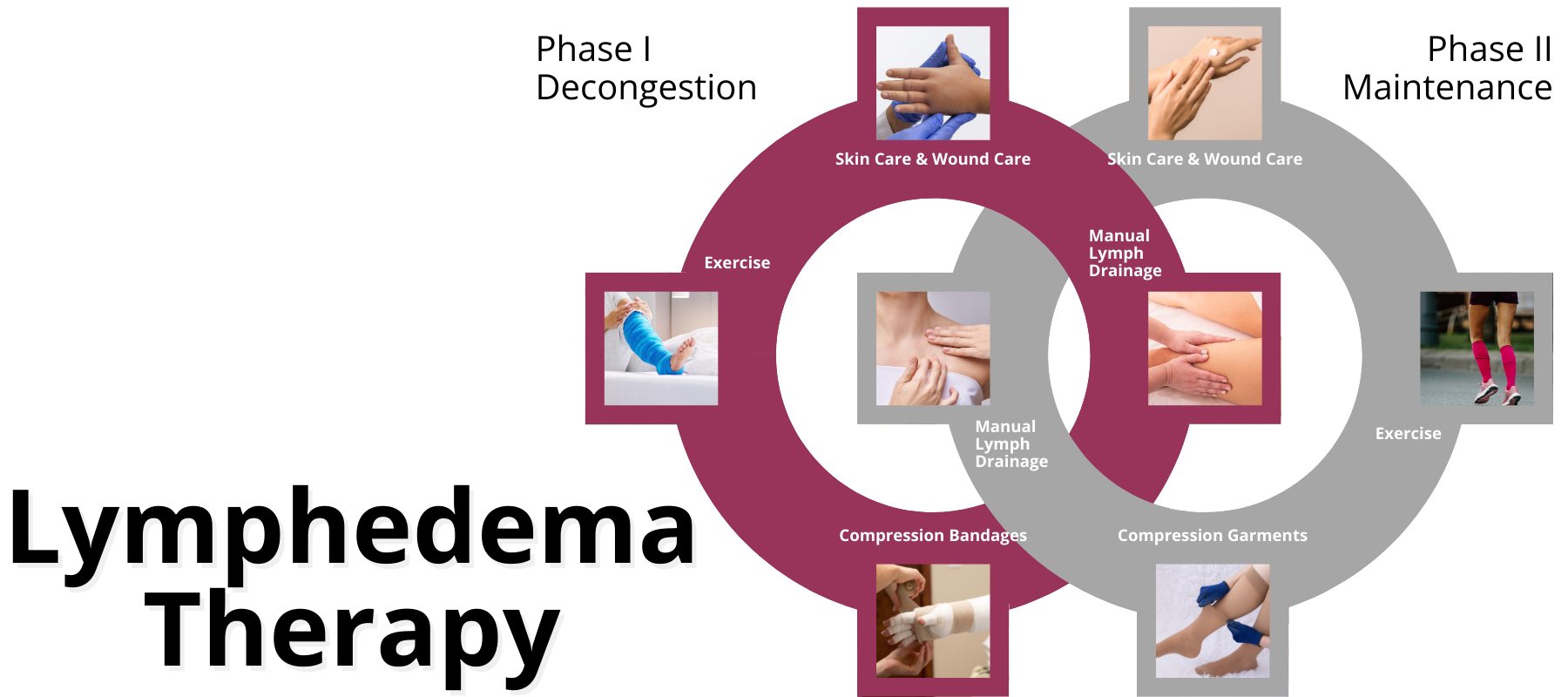| Lymphedema Therapy |
 Complete Decongestive Therapy, sometimes referred to as CDT, is the gold standard of care for lymphedema therapy. Treatment is performed by a trained physical, occupational, or massage therapist, and can also be performed by a trained nurse or doctor. This type of treatment includes both a treatment phase and a maintenance, or self-care, phase. The treatment phase should consist of regular therapy sessions, with the recommended frequency of 5 days a week for several weeks, that include the following components of CDT. Find a Lymphedema Therapist in Your Area Manual Lymph Drainage (MLD) is a specialized form of massage that stimulates the lymphatic system to improve its ability to absorb and transport fluid. MLD uses a light skin stretching technique to stimulate healthy lymphatic vessels and to enable decongestion of swollen body regions. Multi-layered Short Stretch Compression Bandaging is applied following the MLD treatment. Bandages increase tissue pressure and assist with the absorption and transport of lymphatic fluid from the limb and into the normal circulation. These bandages provide support and comfort when the limb is at rest and facilitate gentle pumping pressures when the limb is moving. Movement and gentle exercise are recommended when the limb is bandaged to enhance decongestion of the limb. Education on Skin Care and risk reduction for wounds and infections - Proper skin care promotes healthy tissue and can prevent skin breakdown and infections in the affected tissues. Skin care should include moisturizing the tissue, keeping it clean, and attending to small cuts to prevent infections or chronic wounds. Exercise and training for a home exercise program is incorporated in both phases of treatment and self-care. These exercises are low intensity and repetitive and should be done with compression bandages on the limb. The exercises encourage gentle muscle pumping, which aids the absorption and transport of the lymphatic fluid out of the limb. New research suggests that exercise is not only safe for individuals with lymphedema, it is encouraged to help improve the limb volume, build muscle strength, and promote a healthy lifestyle. Compression Garment Fitting and Training - Compression garments are the primary mode of compression therapy in self-care. Garments play a key role in maintaining the results achieved with skilled therapy. Compression garments need to be fit with the correct size and proper pressure based on the individual’s condition, severity of swelling, and physical ability. Garments are available for any body region and can be ready-made in various sizes or custom-made. Pressure ranges for compression garments are variable and should be recommended by a trained therapist or garment fitter. Intermittent Pneumatic Compression Therapy (IPC) is a supportive intervention for some individuals going through CDT treatment. IPC involves a pneumatic sleeve being applied to the limb which inflates and deflates sequentially applying pressure to encourage fluid absorption and decongestion in the limb. IPC can be used in both treatment and self-care phases. Various types of pneumatic pumps exist to treat lymphedema. Selection and use of IPC should be done in consultation with a trained therapist or fitter. Self-Care - Additional education and instruction for self-care activities to better improve a person’s independence with long-term management of lymphedema. The maintenance, or self-care, phase, begins during regular therapeutic intervention and continues upon discharge from skilled treatment. This includes:
To learn more, watch the videos below. Recorded August 10, 2024 during the virtual NLN's Empowering Patients Series: Lymphedema Treatment Sympoisum Click the buttons below to learn more DISCLAIMER: THIS WEBSITE DOES NOT PROVIDE MEDICAL ADVICE The information, including but not limited to, text, graphics, images, and other material contained on this website are for informational purposes only. No material on this site is intended to be a substitute for professional medical advice, diagnosis or treatment. Always seek the advice of your physician or other qualified healthcare provider with any questions you may have regarding a medical condition or treatment and before undertaking a new health care regimen, and never disregard professional medical advice or delay in seeking it because of something you have read on this website. |